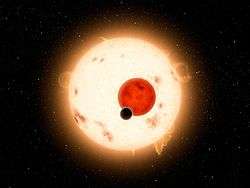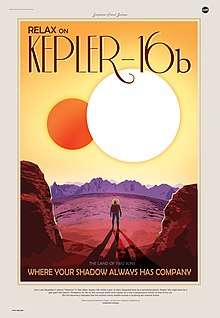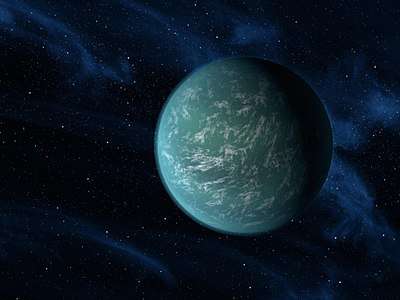Kepler-16b
Kepler-16b (formally Kepler-16 (AB)-b) is an extrasolar planet. It is a Saturn-mass planet consisting of half gas and half rock and ice,[2] and it orbits a binary star, Kepler-16, with a period of 229 days.[1] "[It] is the first confirmed, unambiguous example of a circumbinary planet – a planet orbiting not one, but two stars," said Josh Carter of the Harvard-Smithsonian Center for Astrophysics, one of the discovery team.[3]
 An artist's rendering of the Kepler-16 system, showing the binary star being orbited by Kepler-16b (black body) | |
| Discovery | |
|---|---|
| Discovered by | Laurance Doyle[1] |
| Discovery date | 15 September 2011 |
| Transit (Kepler Mission) | |
| Orbital characteristics | |
| 0.7048 ± 0.0011 AU (105,440,000 ± 160,000 km) | |
| Eccentricity | 0.0069 ± 0.0015 |
| 228.776 ± 0.037 d | |
| Inclination | 90.0322 ± 0.0023 |
| 0.003 ± 0.013 | |
| 106.51 ± 0.32 | |
| 318 ± 22 | |
| Star | Kepler-16 (KOI-1611) |
| Physical characteristics | |
Mean radius | 0.7538 (± 0.0025) RJ |
| Mass | 0.333 (± 0.015) MJ |
Mean density | 0.964 (± 0.047) g cm−3 |
| 14.52 (± 0.7) m/s² | |
| Temperature | 188 K (−85 °C; −121 °F) |
Kepler-16b was discovered using the space observatory aboard NASA's Kepler spacecraft.[4] Scientists were able to detect Kepler-16b using the transit method, when they noticed the dimming of one of the system's stars even when the other was not eclipsing it.[4] Furthermore, duration of transits and timing all the eclipses and transits of Kepler-16b and its stars in the system has allowed for unusually high precision in the calculations of the sizes and masses of objects in the Kepler-16 system.[5] The leader of Kepler-16b's discovery team, Laurance Doyle of the SETI Institute in Mountain View, California, said of this precision, "I believe this is the best-measured planet outside the solar system".[5] For example, Kepler-16b's radius is known to within 0.3%, better than that of any other known exoplanet (as of September 2011).[6]
Kepler-16b is also unusual in that it falls inside the radius that was thought to be the inner limit for planet formation in a binary star system.[5] According to Sara Seager, a planetary expert at the Massachusetts Institute of Technology, it was thought that for a planet to have a stable orbit around such a system, it would need to be at least seven times as far from the stars as the stars are from each other.[5] Kepler-16b's orbit is only about half that distance.[5]
As seen from Earth, Kepler-16b ceased transiting the dimmer star in 2014, and will stop crossing the second, brighter star in 2018. After that, Kepler-16b will remain undetectable using the transit method until around 2042.[5]
Kepler-16b orbits near the outer edge of the habitable zone,[7] but it is probably a gas giant with surface temperatures around −100 to −70 °C (−150 to −94 °F).
Characteristics
Mass, radius and temperature
Kepler-16b is a gas giant, an exoplanet that is near the same mass and radius as the planets Jupiter and Saturn. It has a temperature of 188 K (−85 °C; −121 °F).[8] The planet has a radius of 0.77 RJ, slightly smaller than Saturn, and has no solid surface.
Host stars

The planet orbits in a circumbinary orbit around a (K-type) and (M-type) binary star system. The stars orbit each other about every 41 days. The stars have masses of 0.68 M☉ and 0.20 M☉ and radii of 0.64 R☉ and 0.22 R☉, respectively. They have surface temperatures of 4450 K and 3311 K. Based on the stellar characteristics and orbital dynamics, an estimated age of 2 billion years for the system is possible. In comparison, the Sun is about 4.6 billion years old[9] and has a surface temperature of 5778 K.[10]
Potential habitability
The habitable zone of the Kepler-16 system extends from approximately 55 to 106 million kilometers away from the binary system. Kepler-16b, with an orbit of about 104 million kilometers, lies near the outer edge of this habitable zone. Although the chances of life on the gas giant itself are remote, simulations conducted by researchers at the University of Texas suggest that sometime in the system's history, perturbations from other bodies could have caused an Earth-sized planet from the center of the habitable zone to migrate out of its orbit, allowing Kepler-16b to capture it as its moon.[11] Furthermore, the researchers also considered the possibility of a faraway habitable planet orbiting at about 140 million kilometers away, which could retain the thermal energy needed to keep water liquid through a thick mixture of greenhouse gases including carbon dioxide and methane.
For a stable orbit the ratio between the moon's orbital period Ps around its primary and that of the primary around its star Pp must be < 1/9, e.g. if a planet takes 90 days to orbit its star, the maximum stable orbit for a moon of that planet is less than 10 days.[12][13] Simulations suggest that a moon with an orbital period less than about 45 to 60 days will remain safely bound to a massive giant planet or brown dwarf that orbits 1 AU from a Sun-like star.[14] In the case of Kepler-47c, this would be practically the same to have a stable orbit.
Tidal effects could also allow the moon to sustain plate tectonics, which would cause volcanic activity to regulate the moon's temperature[15][16] and create a geodynamo effect which would give the satellite a strong magnetic field.[17]
To support an Earth-like atmosphere for about 4.6 billion years (the age of the Earth), the moon would have to have a Mars-like density and at least a mass of 0.07 M⊕.[18] One way to decrease loss from sputtering is for the moon to have a strong magnetic field that can deflect stellar wind and radiation belts. NASA's Galileo's measurements hints large moons can have magnetic fields; it found that Jupiter's moon Ganymede has its own magnetosphere, even though its mass is only 0.025 M⊕.[14]
Name
In the announcement paper, the discovery team stated: "Following the convention of Ref. 22,[19] we can denote the third body Kepler-16 (AB)-b, or simply "b" when there is no ambiguity."[1] It is listed as Kepler-16 (AB)-b on the SIMBAD Astronomical Database.[20] The Extrasolar Planets Encyclopaedia lists it as Kepler-16 (AB) b.[21]
The Smithsonian Center has informally referred to Kepler-16b as "Tatooine", a reference to the fictional planet orbiting two suns that is a key setting in the popular Star Wars series.[5] "Again and again we see that the science is stranger and weirder than fiction" said John Knoll, the head visual effects supervisor at Industrial Light & Magic, who worked on several of the movies.[5]
Gallery

References
- Doyle, Laurance R.; Carter, Joshua A.; Fabrycky, Daniel C.; Slawson, Robert W.; Howell, Steve B.; Winn, Joshua N.; Orosz, Jerome A.; Prša, Andrej; Welsh, William F.; et al. (2011). "Kepler-16: A Transiting Circumbinary Planet". Science. 333 (6049): 1602–6. arXiv:1109.3432. Bibcode:2011Sci...333.1602D. doi:10.1126/science.1210923. PMID 21921192.
- Drake, Nadia. "On Kepler-16b, shadows come in pairs". Science News. Society for Science & the Public. Archived from the original on 28 August 2012. Retrieved 16 September 2011.
- "From Star Wars to science fact: Tatooine-like planet discovered". Smithsonian Science. The Smithsonian Institution. Archived from the original on 24 September 2011. Retrieved 24 September 2011.
- Gold, Scott (2011-09-15). "Scientists find planet orbiting two suns like in 'Star Wars'". Los Angeles Times. Retrieved 16 September 2011.
- Overbye, Dennis (2011-09-15). "NASA Detects Planet Dancing With a Pair of Stars". The New York Times. Retrieved 16 September 2011.
- Winn, Joshua N.; Albrecht, Simon; Johnson, John Asher; Torres, Guillermo; Cochran, William D.; Marcy, Geoffrey W.; Howard, Andrew W.; Isaacson, Howard; Fischer, Debra (2011). "Spin-orbit alignment for the circumbinary planet host Kepler-16 A". The Astrophysical Journal. 741 (1): L1. arXiv:1109.3198. Bibcode:2011ApJ...741L...1W. doi:10.1088/2041-8205/741/1/L1.
- https://sites.google.com/a/upr.edu/planetary-habitability-laboratory-upra/library/notes/exoplanetscontinuouslywithinthehabitablezone
- http://www.hpcf.upr.edu/~abel/phl/hec_plots/hec_orbit/hec_orbit_Kepler-47(AB)_c.png
- Fraser Cain (16 September 2008). "How Old is the Sun?". Universe Today. Retrieved 19 February 2011.
- Fraser Cain (September 15, 2008). "Temperature of the Sun". Universe Today. Retrieved 19 February 2011.
- Jaggard, Victoria (January 9, 2012). ""Tatooine" Planet With Two Suns Could Host Habitable Moon?". National Geographic.
- Kipping, David (2009). "Transit timing effects due to an exomoon". Monthly Notices of the Royal Astronomical Society. 392 (1): 181–189. arXiv:0810.2243. Bibcode:2009MNRAS.392..181K. doi:10.1111/j.1365-2966.2008.13999.x.
- Heller, R. (2012). "Exomoon habitability constrained by energy flux and orbital stability". Astronomy & Astrophysics. 545: L8. arXiv:1209.0050. Bibcode:2012A&A...545L...8H. doi:10.1051/0004-6361/201220003. ISSN 0004-6361.
- Andrew J. LePage (August 2006). "Habitable Moons:What does it take for a moon — or any world — to support life?". SkyandTelescope.com. Retrieved 2011-07-11.
- Glatzmaier, Gary A. "How Volcanoes Work – Volcano Climate Effects". Retrieved 29 February 2012.
- "Solar System Exploration: Io". Solar System Exploration. NASA. Retrieved 29 February 2012.
- Nave, R. "Magnetic Field of the Earth". Retrieved 29 February 2012.
- "In Search Of Habitable Moons". Pennsylvania State University. Retrieved 2011-07-11.
- Hessman, F. V.; Dhillon, V. S.; Winget, D. E.; Schreiber, M. R.; Horne, K.; Marsh, T. R.; Guenther, E.; Schwope, A.; Heber, U. (2010). "On the naming convention used for multiple star systems and extrasolar planets". 1012: 707. arXiv:1012.0707. Bibcode:2010arXiv1012.0707H. Cite journal requires
|journal=(help) - Object query: Kepler-16b on the online SIMBAD Astronomical database
- Jean Schneider (2011). "Notes for Planet Kepler-16 (AB) b". Extrasolar Planets Encyclopaedia. Retrieved 23 September 2011.
External links
![]()


.jpg)